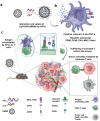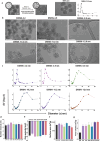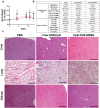Optimized Fabrication of Dendritic Mesoporous Silica Nanoparticles as Efficient Delivery System for Cancer Immunotherapy
- PMID: 39375971
- PMCID: PMC11636195
- DOI: 10.1002/smll.202402802
Optimized Fabrication of Dendritic Mesoporous Silica Nanoparticles as Efficient Delivery System for Cancer Immunotherapy
Abstract
In the past decade, cancer immunotherapy has revolutionized the field of oncology. Major immunotherapy approaches such as immune checkpoint inhibitors, cancer vaccines, adoptive cell therapy, cytokines, and immunomodulators have shown great promise in preclinical and clinical settings. Among them, immunomodulatory agents including cancer vaccines are particularly appealing; however, they face limitations, notably the absence of efficient and precise targeted delivery of immune-modulatory agents to specific immune cells and the potential for off-target toxicity. Nanomaterials can play a pivotal role in addressing targeting and other challenges in cancer immunotherapy. Dendritic mesoporous silica nanoparticles (DMSNs) can enhance the efficacy of cancer vaccines by enhancing the effective loading of immune modulatory agents owing to their tunable pore sizes. In this work, an emulsion-based method is optimized to customize the pore size of DMSNs and loaded DMSNs with ovalbumin (OVA) and cytosine-phosphate-guanine (CpG) oligodeoxynucleotides (CpG-OVA-DMSNs). The immunotherapeutic effect of DMSNs is achieved through controlled chemical release of OVA and CpG in antigen-presenting cells (APCs). The results demonstrated that CpG-OVA-DMSNs efficiently activated the immune response in APCs and reduced tumor growth in the murine B16-OVA tumor model.
Keywords: cancer vaccines; delivery platform; dendritic mesoporous silica nanoparticles; immunotherapy.
© 2024 The Author(s). Small published by Wiley‐VCH GmbH.
Conflict of interest statement
The authors declare no conflict of interest.
Figures






References
-
- Tan S., Li D., Zhu X., Biomed. Pharmacother. 2020, 124, 109821. - PubMed
-
- Nghiem P., Bhatia S., Lipson E. J., Sharfman W. H., Kudchadkar R. R., Brohl A. S., Friedlander P. A., Daud A., Kluger H. M., Reddy S. A., Boulmay B. C., Riker A. I., Burgess M. A., Hanks B. A., Olencki T., Margolin K., Lundgren L. M., Soni A., Ramchurren N., Church C., Park S. Y., Shinohara M. M., Salim B., Taube J. M., Bird S. R., Ibrahim N., Fling S. P., Homet Moreno B., Sharon E., Cheever M. A., et al., J. Clin. Oncol. 2019, 37, 693. - PMC - PubMed
-
- Lin M. J., Svensson‐Arvelund J., Lubitz G. S., Marabelle A., Melero I., Brown B. D., Brody J. D., Nat. Cancer 2022, 3, 911. - PubMed
-
- Saxena M., van der Burg S. H., Melief C. J. M., Bhardwaj N., Nat. Rev. Cancer 2021, 21, 360. - PubMed
Publication types
MeSH terms
Substances
Grants and funding
- NIH T32AI007273/Basic Immune Mechanisms Training Program
- R01 CA263897/CA/NCI NIH HHS/United States
- P50 CA058223/NH/NIH HHS/United States
- State of North Carolina
- P30 CA016086/CA/NCI NIH HHS/United States
- P50 CA058223/CA/NCI NIH HHS/United States
- P30CA016086/UNC Lineberger Comprehensive Cancer Center
- NIH T32CA196589/Carolina Cancer Nanotechnology Training Program
- T32 AI007273/AI/NIAID NIH HHS/United States
- UNC Center for Environmental Health and Susceptibility
- R01CA263897/NH/NIH HHS/United States
- T32 CA196589/CA/NCI NIH HHS/United States
- 2015-IDG-1007/North Carolina Biotechnology Center
- National Institute of Cancer
LinkOut - more resources
Full Text Sources
Miscellaneous

